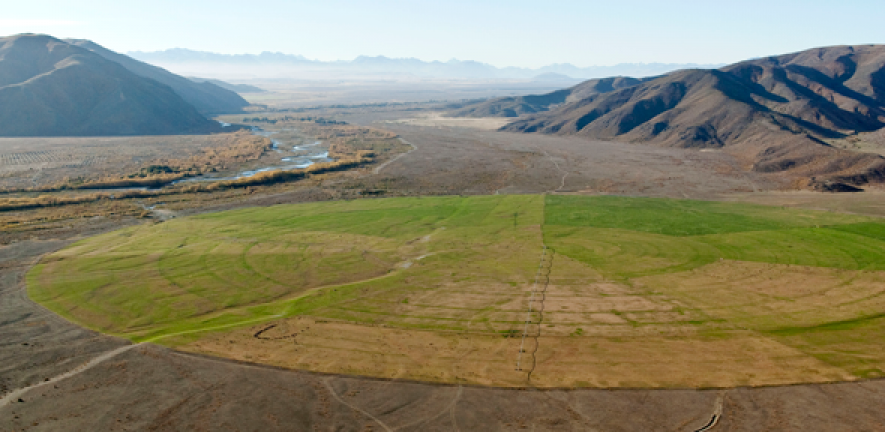
First analysis of effectiveness of agri-environment schemes measured at a national level suggests that they work, but are still a drop in the ocean compared to huge government subsidies received by farming industries for environmentally damaging practices.
First analysis of effectiveness of agri-environment schemes measured at a national level suggests that they work, but are still a drop in the ocean compared to huge government subsidies received by farming industries for environmentally damaging practices.
Part of the job of a farmer – needs to be protecting the countryside as well as farming it
Andrew Tanentzap
New research suggests that offering financial incentives for farming industries to mitigate the impact agriculture has on the environment, by reducing fertiliser use and ‘sparing’ land for conservation, for example, actually has a positive effect on critical areas such as greenhouse gas reduction and increased biodiversity.
It has been a point of contention whether such ‘cash for conservation’ initiatives succeed. For the latest study, researchers aggregated investment in environmental incentives at a national level for the first time, and, by comparing them to broad trends in environmental outcomes, found that paying the agriculture industry to help the environment seems to be working.
However, the research team also mapped the proportion of global agricultural production reinvested in environmental incentives, and compared it to the proportion gifted to the industry through government subsidies. As expressed in pie charts, the results show big wedges of subsidy stacked on top of barely perceptible slivers of environmental investment.
For example, around 20% of the value of agriculture production in the EU is subsidised by the taxpayer. However, less than 1% goes towards mitigating the toll farming takes on the natural world – despite agriculture contributing more to environmental degradation than any other economic sector, say researchers.
The team describe current agriculture funding models as ‘perverse subsidies’: promoting negative actions in both the long and short term by being bad for the environment and costly to the economy.
They argue for a redressing of the massive imbalance between government money spent on farming subsidies, and that spent on lessening the damage farming does to the environment.
Consumption of environmental services, such as water (crop irrigation alone counts for 70% of the world’s freshwater withdrawals), should be taxed, say the researchers, and any subsidies should be paid on the proviso that they are as much for protecting the land as for farming it.
“Our results show that paying farmers to do things that are good for the environment actually seems to work when averaged across national scales,” said lead author Dr Andrew Tanentzap.
“In many parts of the world, governments already provide huge subsidies to the agriculture industry; if we are paying people to be farmers, part of that payment – indeed, part of the job of a farmer – needs to be protecting the countryside as well as farming it,” he said. “We need a shift in what it means to be a farmer.”
The work, conducted by researchers from Cambridge University’s departments of Plant Sciences and Zoology, is published today in the open access journal PLOS Biology.
While national data for environmental performance is limited and difficult to quantify, the research team were able to plot investment in two key agri-environment schemes, land ‘retirement’ for conservation and limiting fertiliser use, against national trends for farmland bird populations and emissions from synthetic fertiliser across landmasses including the US, Canada, Australia and Europe.
They found that, broadly speaking, higher national investment in these environmentally-friendly incentive schemes over a five-year period correlated with increased levels of bird biodiversity and lower rates of gas emissions from farming.
“There’s controversy around whether such environmental incentives actually work at a local scale. What we’ve done is average out the local effects to pull out what’s happening on a very large scale, and it looks like there are benefits to paying farmers to be kinder to the environment,” said Tanentzap.
However, Tanentzap points out that paying farmers to be more environmentally-friendly won’t solve the problem of food security, and if these schemes reduce crop yields it may result in increased production elsewhere: “displacing the impacts that we are paying some farmers to mitigate”. He says that, in the worst cases, this results in further land being sucked into the agricultural churn.
“A result of many agri-environment schemes is the spreading out – or ‘sharing’ – of land for both farming and the natural environment. A lot of research, much of it driven by conservation scientists here in Cambridge, shows that this is less effective than simply removing the land from production – ‘sparing’ it for conservation.”
“The most logical solution would be to intensify production on existing lands, trying to minimise environmental impacts with regulations, incentives for good environmental performance, or consumption taxes, while protecting land elsewhere for conservation,” Tanentzap said.
The researchers say that tackling the huge disparity between government subsidies and environmental incentives needs to be the first step in reducing conflict between agriculture and the natural environment, something they say has traditionally been difficult to achieve because of the power behind agri-food lobbies.
They write that while governments continue to subsidise production and famers are not accountable for the costs of their actions because associated penalties are trivial, damaging the environment will remain highly financially lucrative – with devastating consequences.
However, simply removing subsidies alone fails to reduce environmental harm, and incentives for better farming practices are still required. In the paper, researchers look at the case of New Zealand, where there are no subsidies or mitigation schemes, and much of the country has been transformed into a massive dairy farm for China as a result, says Tanentzap.
“Subsidies for production date from the post-war era, when feeding a booming population was paramount. Food security is, of course, still a major issue as populations continue to rise, but there are ways to deliver this without destroying the planet,” Tanentzap said.
“If the agriculture industry is to be subsidised, then paying farmers to protect the environment – rather than just stripping as much use from the land as possible – is something our study has shown to be effective, and something the natural world is in dire need of.”
Reference:
Tanentzap AJ, Lamb A, Walker S, Farmer A (2015) Resolving Conflicts between Agriculture and the Natural Environment. PLoS Biol 13(9): e1002242. doi:10.1371/journal.pbio.1002242

The text in this work is licensed under a Creative Commons Attribution 4.0 International License. For image use please see separate credits above.




